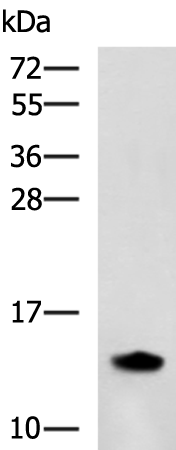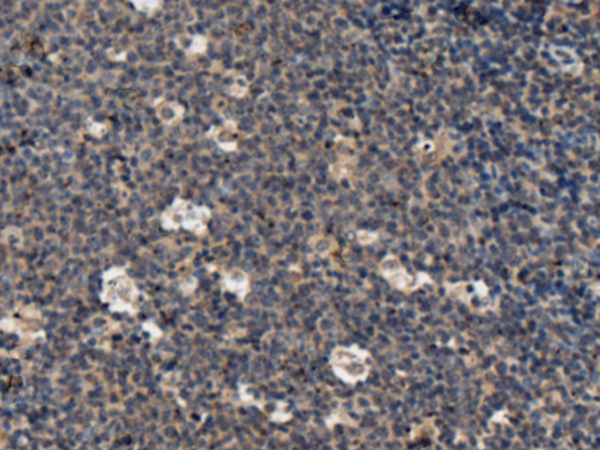

| WB | 咨询技术 | Human,Mouse,Rat |
| IF | 咨询技术 | Human,Mouse,Rat |
| IHC | 1/200-1/400 | Human,Mouse,Rat |
| ICC | 技术咨询 | Human,Mouse,Rat |
| FCM | 咨询技术 | Human,Mouse,Rat |
| Elisa | 1/5000-1/10000 | Human,Mouse,Rat |
| Aliases | MM46; ATG8A; GABARAP-a |
| WB Predicted band size | 14 kDa |
| Host/Isotype | Rabbit IgG |
| Antibody Type | Primary antibody |
| Storage | Store at 4°C short term. Aliquot and store at -20°C long term. Avoid freeze/thaw cycles. |
| Species Reactivity | Human, Mouse, Rat |
| Immunogen | Fusion protein of human GABARAP |
| Formulation | Purified antibody in PBS with 0.05% sodium azide and 50% glycerol. |
+ +
以下是关于GABARAP抗体的3篇参考文献,涵盖功能研究、抗体应用及疾病关联:
---
1. **"LC3. GABARAP and GATE16 localize to autophagosomal membrane depending on form-II formation"**
- **作者**: Kabeya, Y., et al. (2000)
- **摘要**: 该研究通过免疫荧光和Western blot技术,使用特异性抗体验证了GABARAP及其同源蛋白LC3在自噬体膜上的定位。结果表明,GABARAP的脂化形式(II型)与自噬体形成密切相关,抗体被用于追踪自噬过程中的亚细胞定位变化。
2. **"Structural analysis of GABARAP and its interaction with the GABA(A) receptor"**
- **作者**: Schwarten, M., et al. (2009)
- **摘要**: 利用GABARAP抗体进行免疫共沉淀和结构生物学研究,揭示了GABARAP与γ-氨基丁酸A型受体(GABA(A)R)的相互作用机制,阐明其在神经递质受体运输中的调控作用。
3. **"Nix is a selective autophagy receptor for mitochondrial clearance"**
- **作者**: Novak, I., et al. (2010)
- **摘要**: 研究通过GABARAP抗体检测线粒体自噬过程中GABARAP的募集,证明其与受体蛋白Nix协同作用,促进受损线粒体的清除,为选择性自噬机制提供了实验依据。
---
这些文献展示了GABARAP抗体在自噬机制、蛋白互作及疾病模型中的关键应用,适用于基础研究与病理学探索。如需扩展至4篇,可补充关于抗体特异性验证的研究(如Sato et al.制备单克隆抗体的论文)。
GABARAP (Gamma-aminobutyric acid receptor-associated protein) is a ubiquitin-like protein belonging to the Atg8 protein family, which plays critical roles in autophagy, a conserved cellular degradation process. Initially identified for its interaction with GABAA receptors in the central nervous system, GABARAP is involved in receptor trafficking and synaptic function. However, its primary function extends to autophagy, where it participates in autophagosome formation, cargo recruitment, and lysosomal fusion. GABARAP facilitates the lipidation of LC3 (another Atg8 homolog) and mediates membrane tethering events during autophagosome maturation.
Antibodies targeting GABARAP are essential tools for studying autophagy dynamics, neurodevelopment, and disease mechanisms. They are widely used in techniques like Western blotting, immunofluorescence, and co-immunoprecipitation to detect expression levels, subcellular localization, and protein interactions. GABARAP dysregulation has been implicated in neurodegenerative disorders (e.g., Alzheimer’s and Parkinson’s diseases), cancer, and metabolic syndromes, making its antibodies valuable for both basic research and clinical diagnostics.
Studies also highlight GABARAP’s role beyond autophagy, including apoptosis, innate immunity, and organelle organization. Its antibodies help elucidate crosstalk between these pathways, particularly under stress conditions. Researchers often use GABARAP antibodies alongside other autophagy markers (e.g., LC3B, p62) to comprehensively assess autophagic flux. Validated specificity and cross-reactivity checks are critical, given the high homology among Atg8 family members. Overall, GABARAP antibodies serve as pivotal reagents for decoding cellular homeostasis and disease pathology linked to autophagy and membrane trafficking.
×